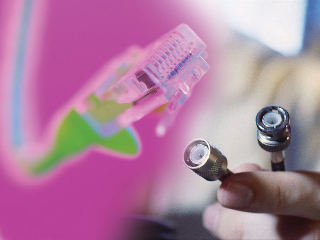As the government and private payors increase the use of the Internet to provide fee schedules or to perform electronic billing, your staff may be frustrated with the time it takes to do such tasks with a traditional 56K "dial-up" modem. Eventually, some surgeons say, practices will have to go to broadband Internet connections, which can boost data transfer speeds by as much as 25 times over a dial-up. Here are the pros and cons of the two main technologies.
Cable Modem
A broadband Internet connection is defined in terms of speed. If your connection allows you to download files, images, music, etc., from the Internet or send them over e-mail faster than about 250 kilobits per second, it's considered broadband.
One of the two currently popular broadband connections is a cable modem. A cable modem uses a cable television line, installed by your local cable company, to bring you the Internet. The actual cable modem itself, which you can buy or rent from the cable company, is attached to your computer and allows it to access the Web via the cable. A business broadband account costs between $60 and $100 per month, depending on your area and extras such as e-mail accounts.
Southampton, Pa., ophthalmologist Richard Prince has a cable modem in his group practice and says, "Once you've touched broadband, you can never go back to a dial-up connection."
Dr. Prince's insurance coordinator, Nancy Fisher, uses the connection constantly. "In our network, a patient's primary-care physician puts in a referral that's directed by fax to you," Mrs. Fisher explains. "But sometimes they put in the wrong fax number; then the patient arrives but we don't have his referral. With a Web service called NaviNET, any of us can click a few times and see the referral on-line. Though I could do it before, I'd have to dial in and wait up to five minutes as the patient grew impatient." She says just getting into websites such as that of the Centers for Medicare and Medicaid Services is "so much quicker ... there's no waiting for the dial-up. If you have to visit the site 10 times during the day and it's a five-minute wait each time with the dial-up modem, that's almost an hour you've wasted." She says it's becoming more necessary to have a fast connection because more insurance carriers are becoming very Web-centric. "A lot of carriers refer you to their websites for policy bulletins or to download procedures manuals," she says.
 |
Second, it's always on when your computer's on. This can be a security risk, since an intruder could invade your machine. This is remedied, however, with what's called a firewall, which prevents unauthorized access. A firewall can be purchased for $100 or a bit less.
Another problem might occur if you get e-mail accounts along with your cable connection. Cable companies on the lookout for junk e-mail, or "spam," may set their systems to block mail from computers they suspect are sending spam. If your practice sends a lot of e-mail, your e-mail provider may be inadvertently blocked by the cable company.
Digital Subscriber Line (DSL)
While cable Internet access rides piggyback on cable signals, DSL access comes across on an even more common technology: the telephone.
For about the same price as cable modem access, your phone company (if it offers DSL) will run a line to your practice to allow Internet access at around the same speed as a cable connection. Similar to how a cable modem's performance deteriorates as the number of users increases, however, a DSL line's speed slows as you get farther from the nearest telephone switching point, out to a maximum of about 18,000 feet. If you're any farther, you can't get DSL at all. In fact, experts recommend a trial period during which you can cancel your DSL subscription, just to make sure your connection isn't too slow.
Medina, Ohio, ophthalmologist Joe Noreika has a cable modem at his main office and a DSL line at his satellite location, and, though he says he favors the cable modem a bit for its slightly faster speed, the DSL has been "satisfactory," and still much faster than a 56K dial-up connection.
"I recently had to resort to a dial-up connection," he says. "And it was painful."
He says one of the key benefits is that his practice can do more submissions via electronic data interchange. "If you're going to do EDI, you need broadband," he says. "This is actually a tangible payback, because when you instantly put the charges to the payer over the Internet, you can see your accounts receivable go down."
He also uses his connections to send digital images, and appreciates the speed here, as well. "It takes about a minute and a half to send an image," he says. "And that's at a high resolution. A visual field could take just seconds at low-res."
Dr. Noreika also says, however, not to expect the maximum connection speed your vendor quotes. "It won't get any better than that," he says. "That's the max, and it will deteriorate off of that. You can count on it being exponentially faster than a 56K modem dial-up, though."



